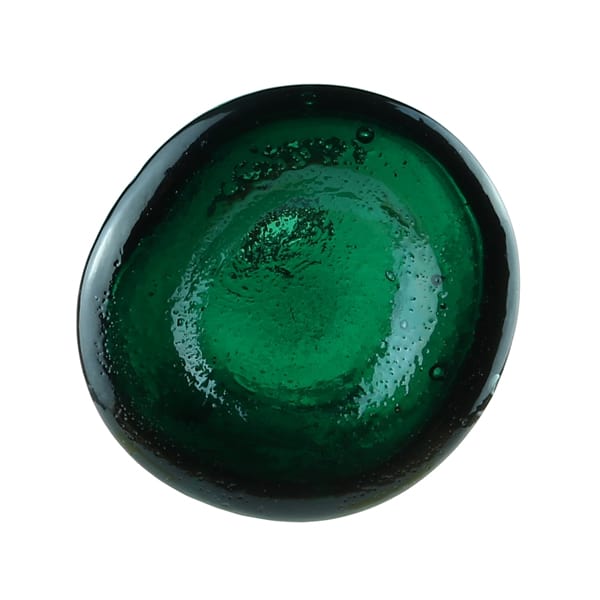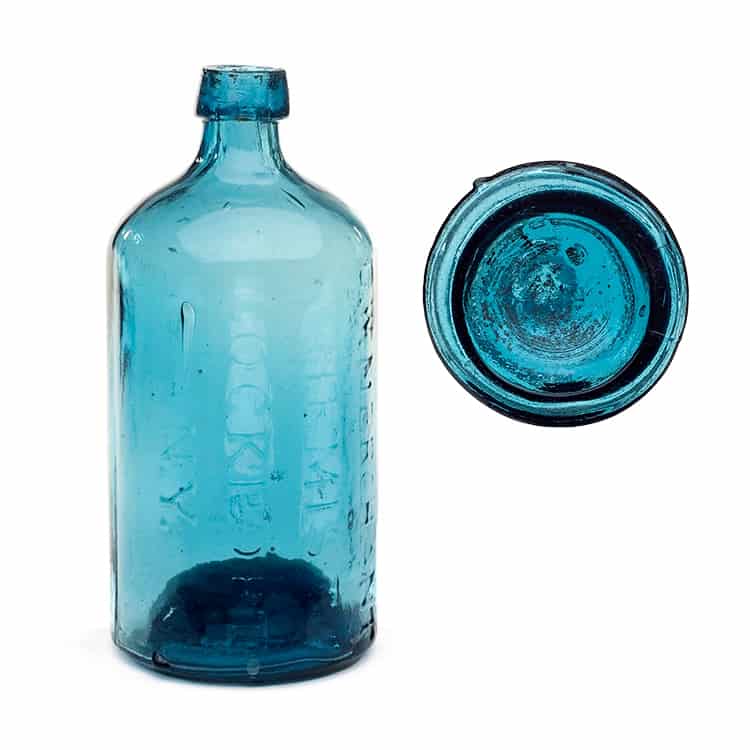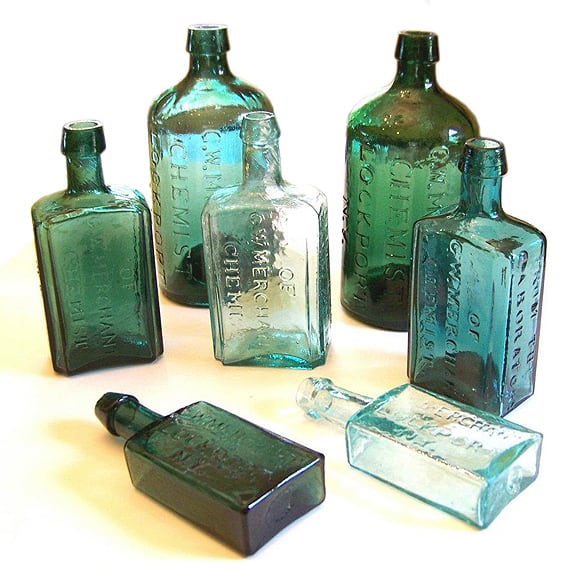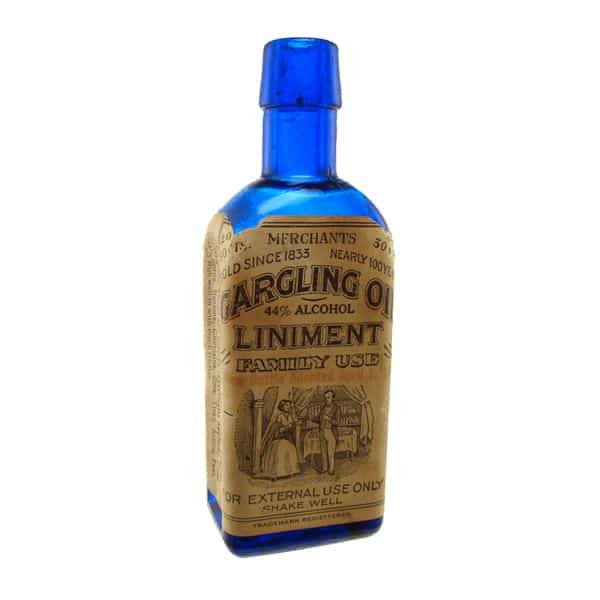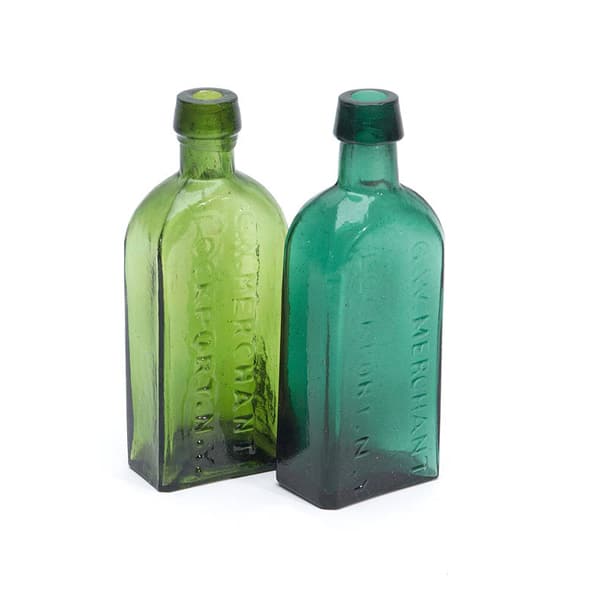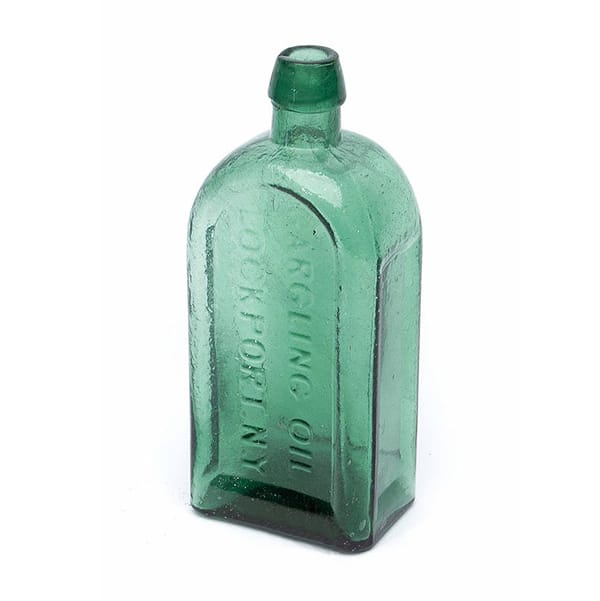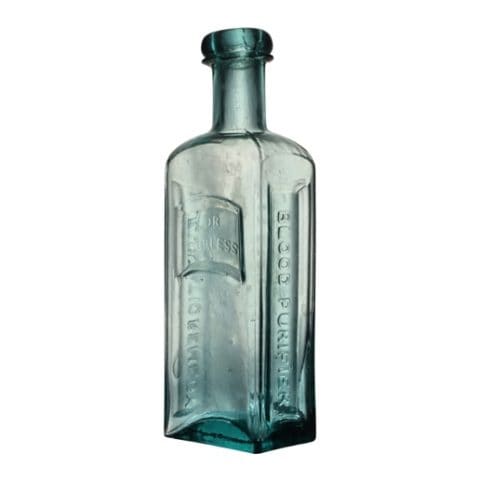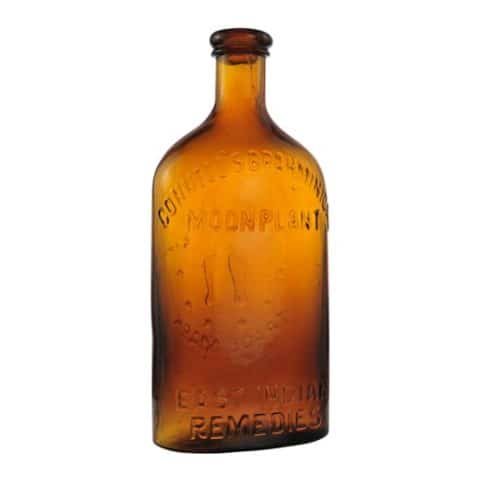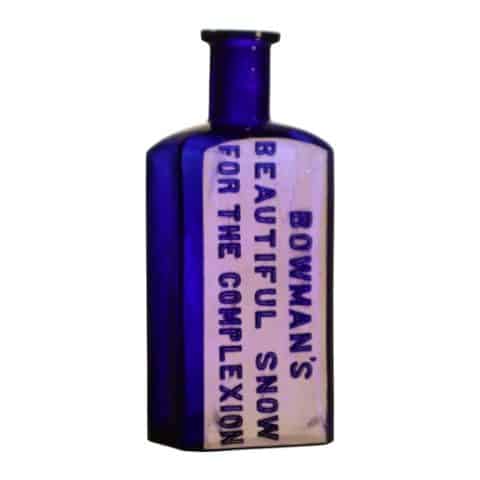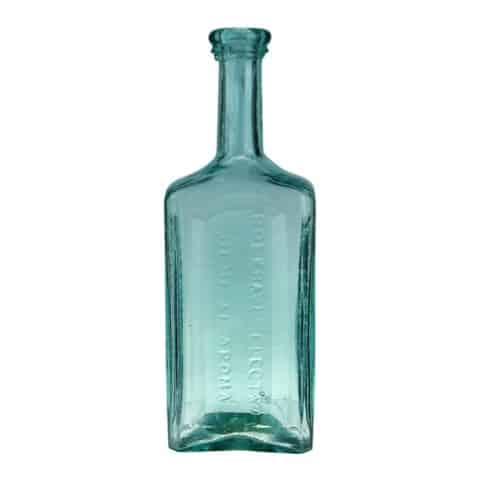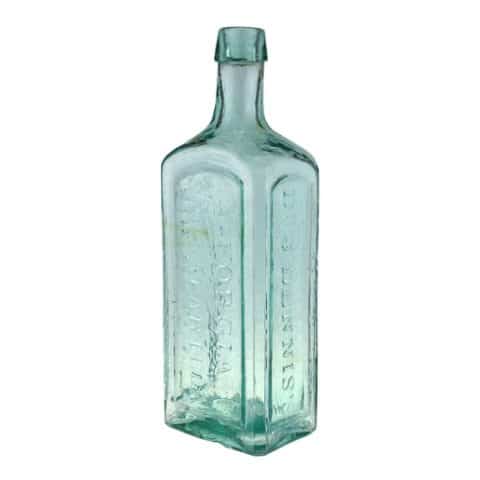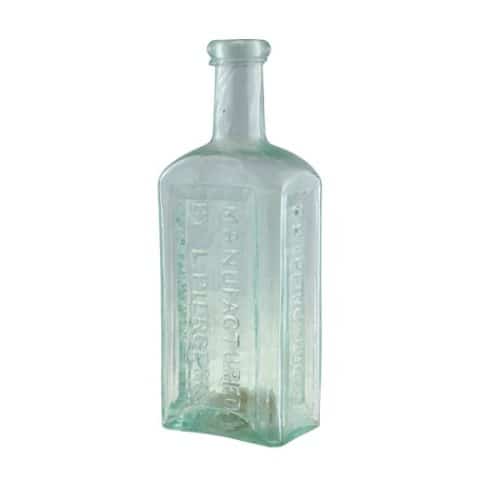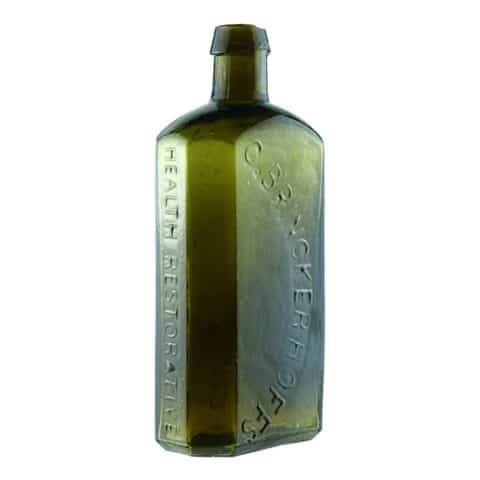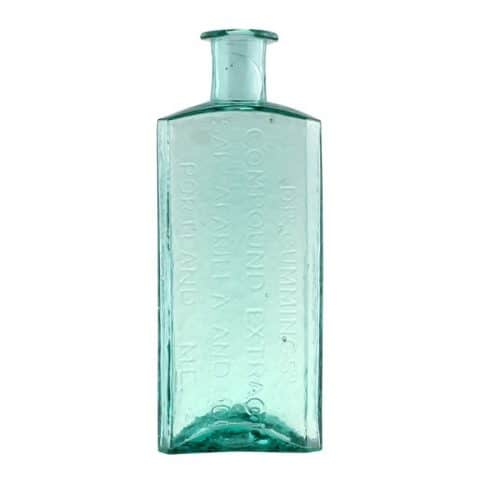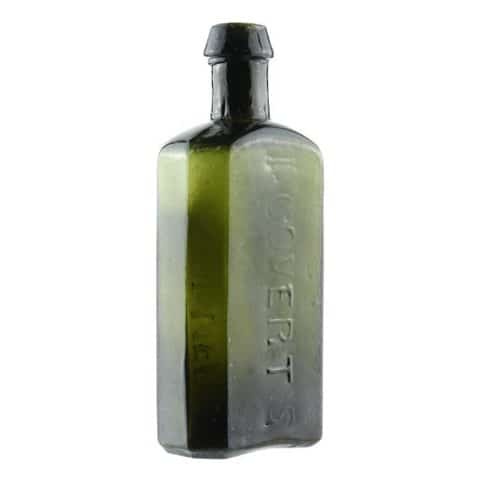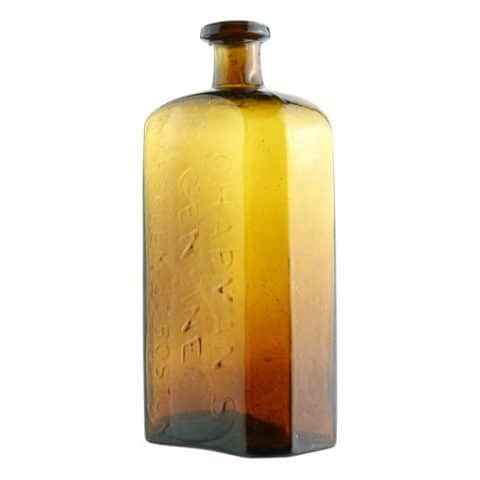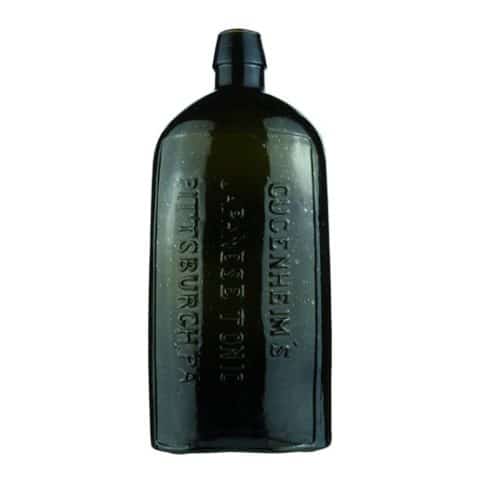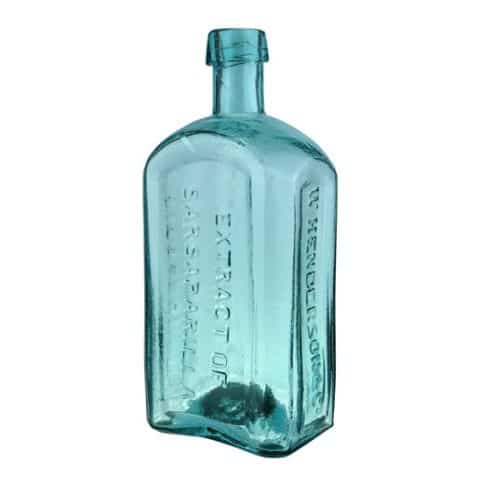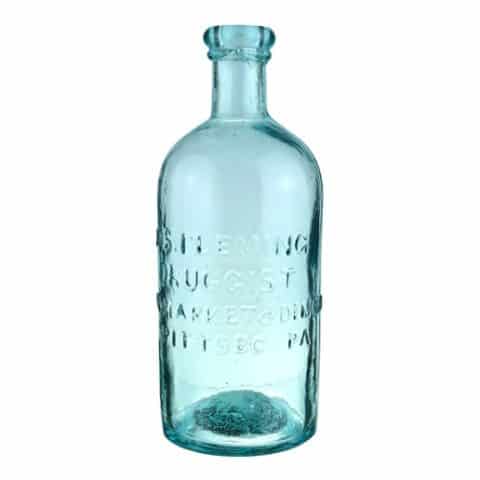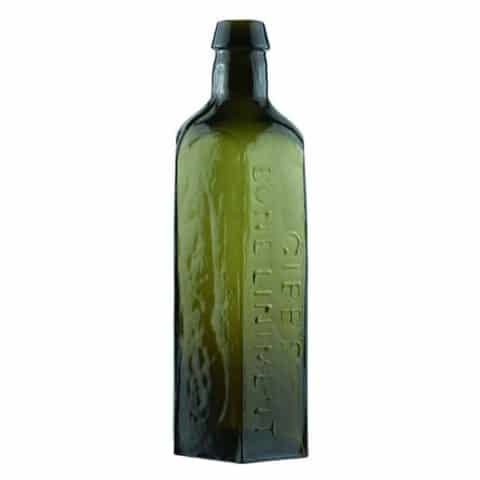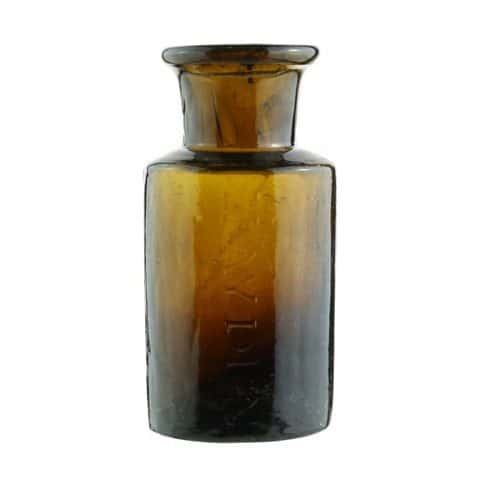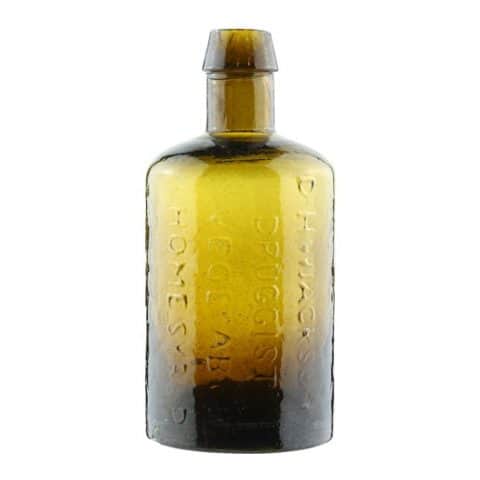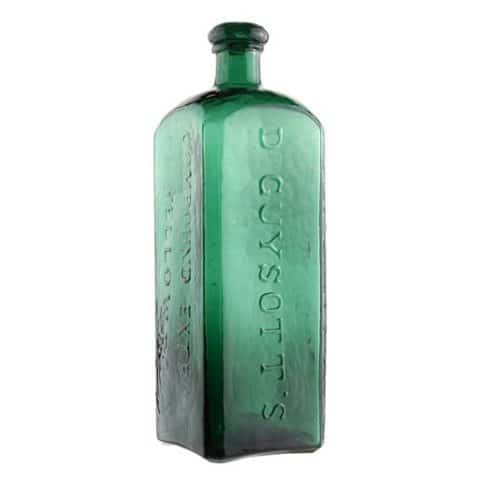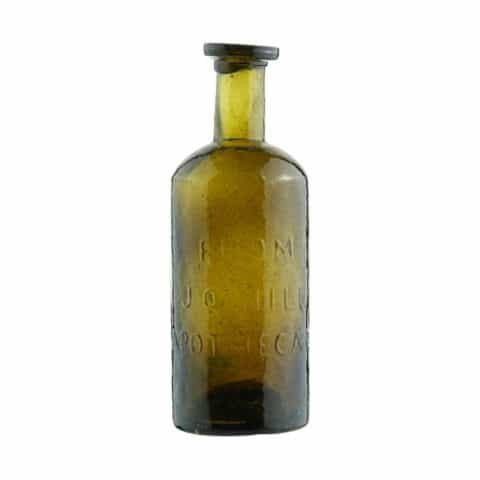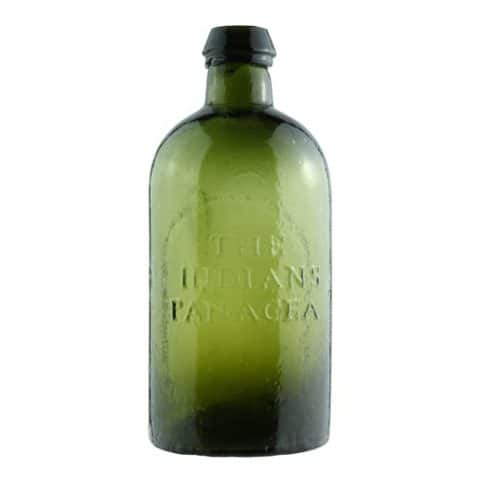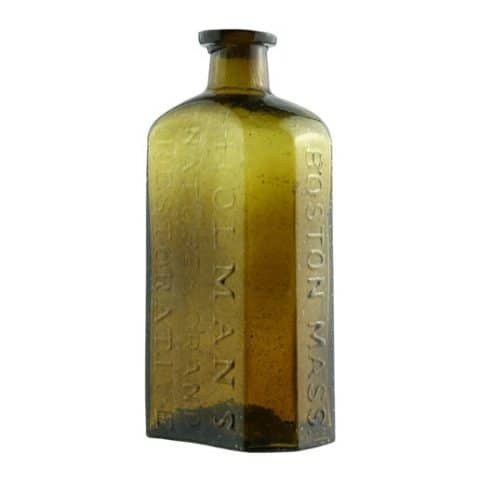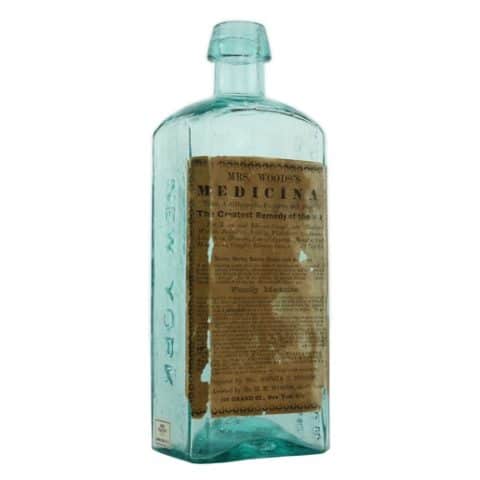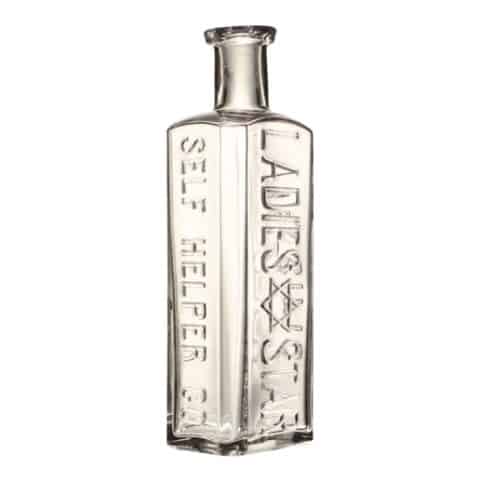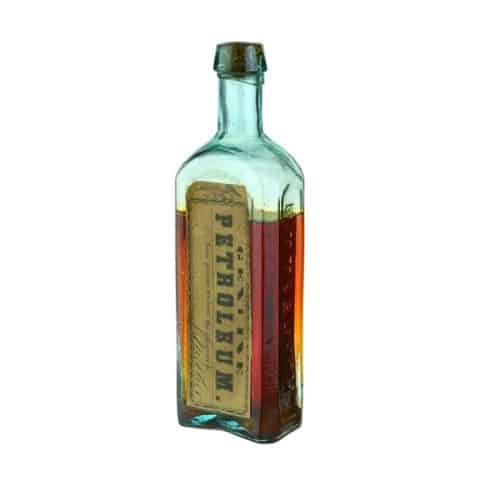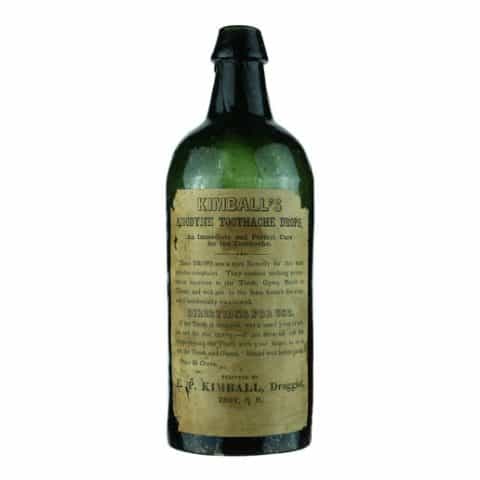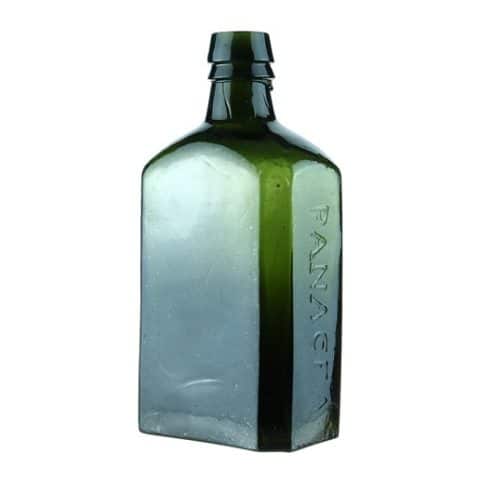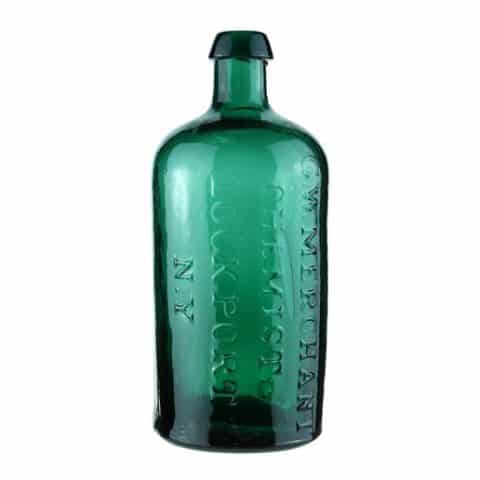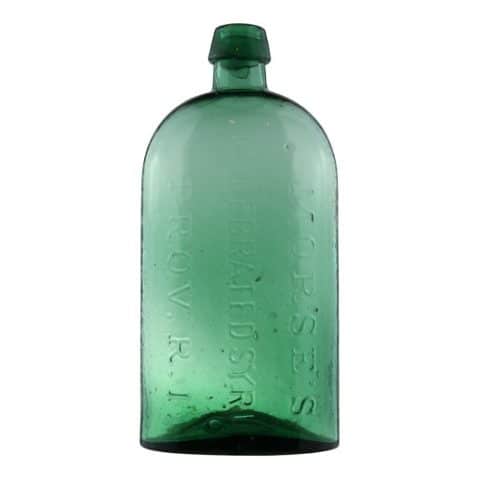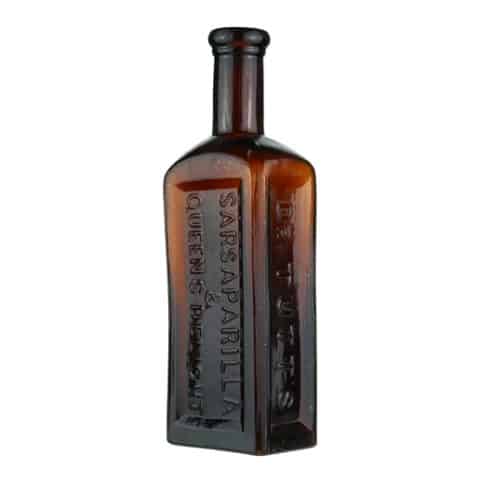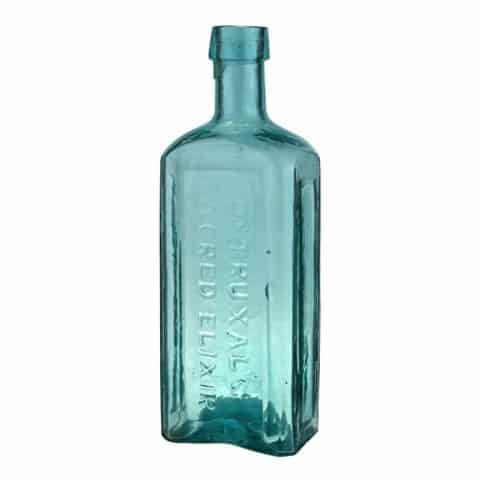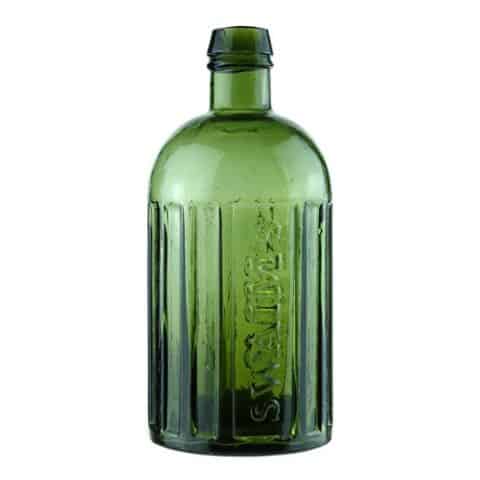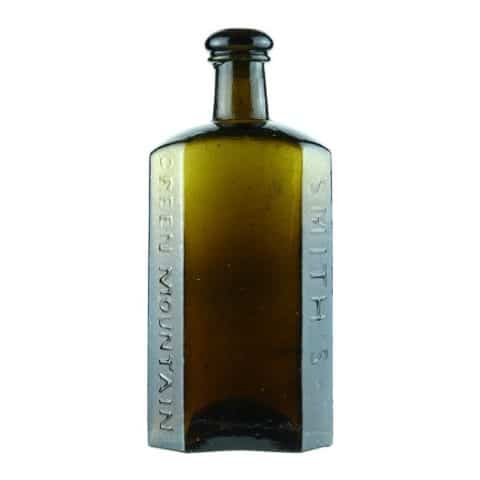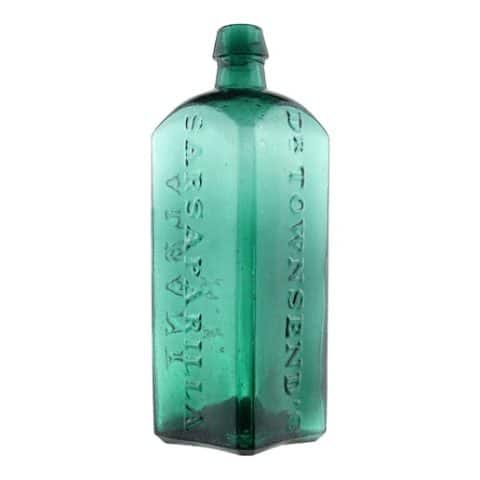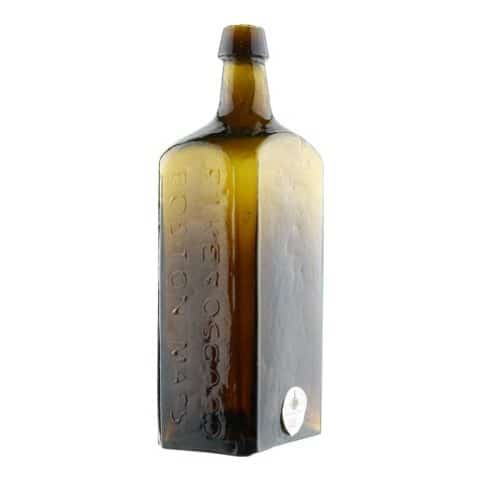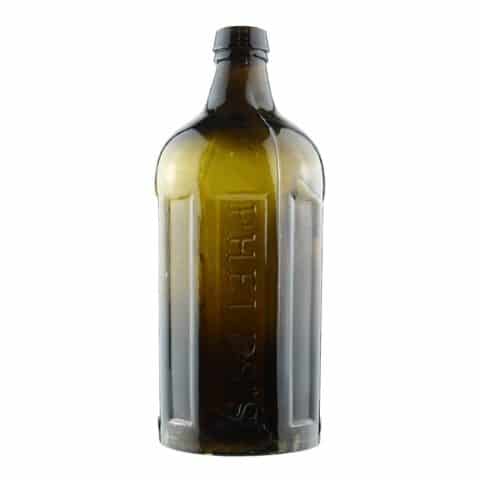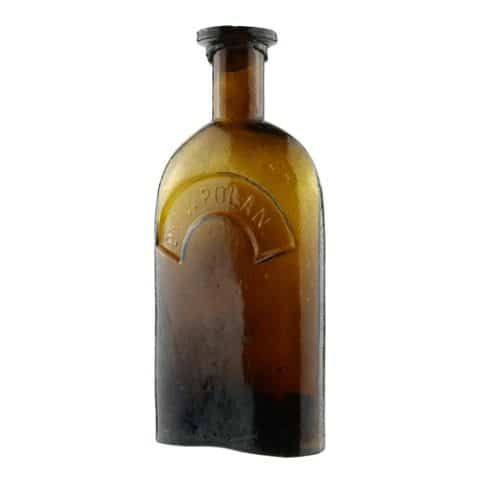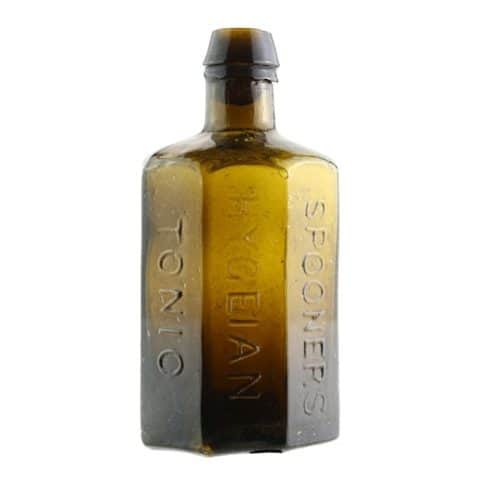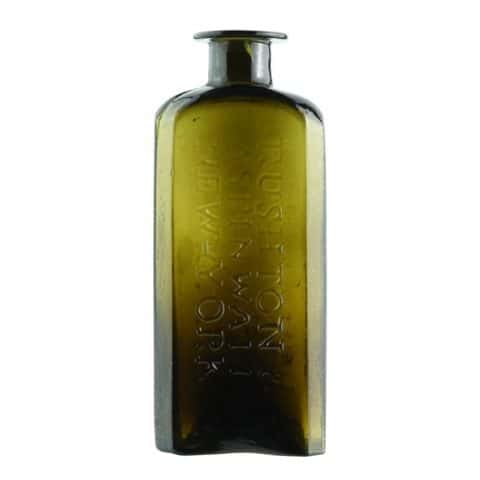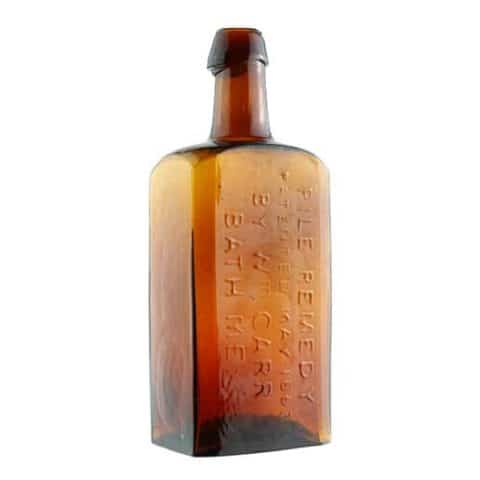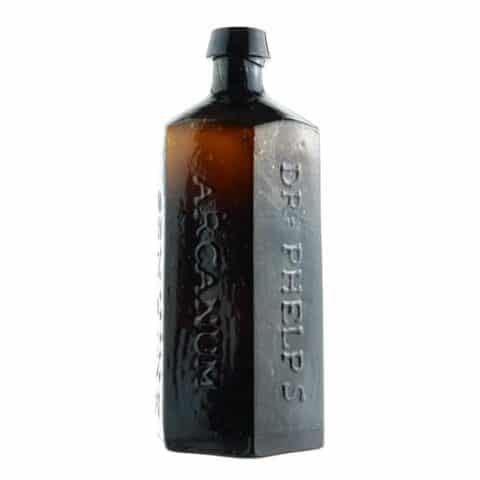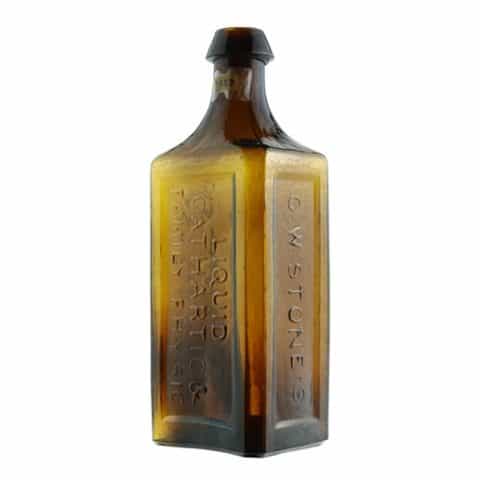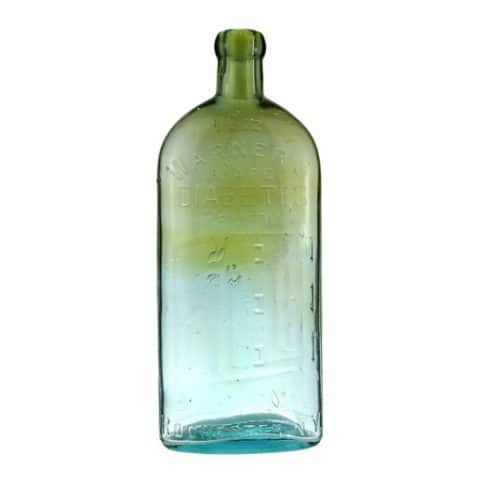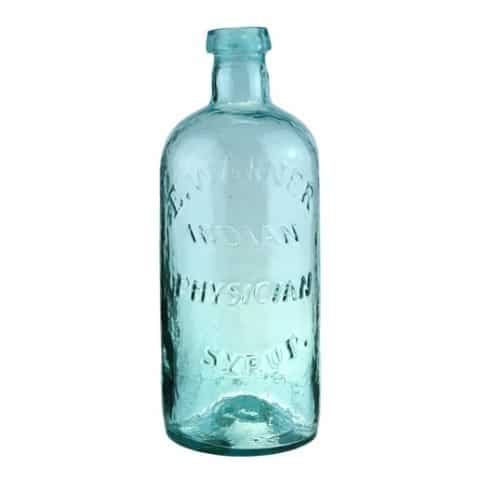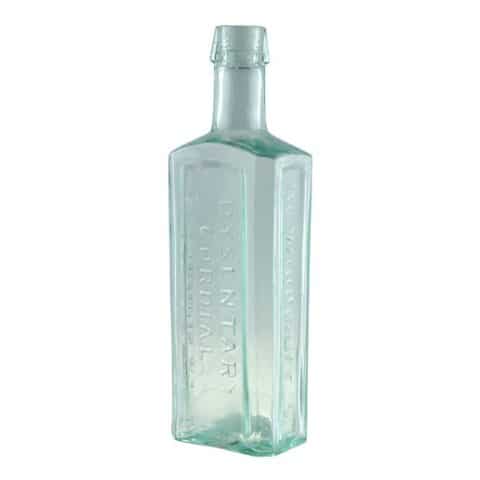G.W. Merchant Chemist Lockport N.Y.
G.W. Merchant
Chemist
Lockport N.Y.
George W. Merchant, Lockport, New York
Lockport Glass Works, Lockport, New York
Teal Green
Provenance: Chris Bubash Collection
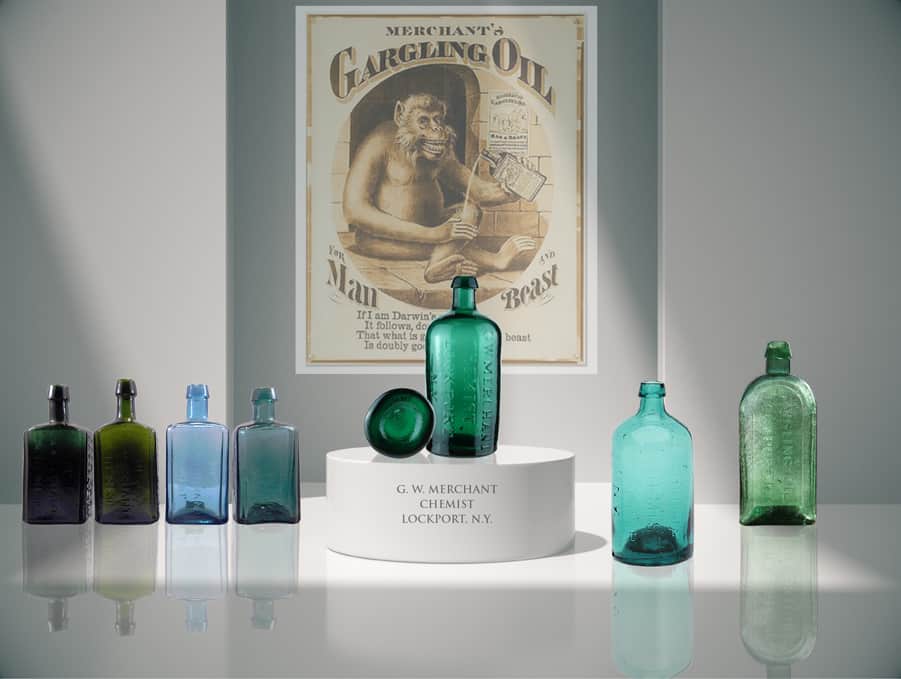
The G. W. Merchant name is a favorite with antique bottle collectors. The round and rectangular bottles can be found in various sizes and molds and in pleasing glass colors representing Lockport Glass Works, in New York.
Our feature round bottle is 7″ tall by 3″ wide and is embossed in four centered and vertical, shoulder-to-base lines of serifed copy. The first line reads ‘G. W. MERCHANT,’ the second line ‘CHEMIST,’ third line ‘LOCKPORT,’ and the fourth line, ‘N.Y.’ There is no period after the “Y.’ There is an applied sloping collared mouth, rounded shoulders, and a depressed bottom with what appears to be a sand-type pontil. The round form is very misshapen as evidenced by looking at the bottom of the teal green bottle.
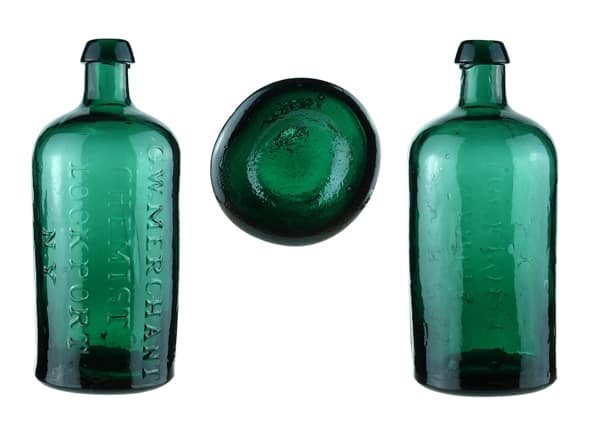
Merchant’s Gargling Oil Co. of Lockport, New York, was founded by Dr. George W. Merchant, a druggist, and chemist, in 1833. The first incarnation of Dr. Merchant’s Gargling Oil was a liniment intended to cure almost any illness that could befall a domestic animal. Merchant initially sold his medicine to drivers of horses and mules alongside the Erie Canal, who apparently needed frequent doses to soothe their animal’s aches and pains.
Dr. Merchant started in “Lower Town” and moved to “Upper Town” Lockport in 1836, where he sold his product locally. Demand for his medicine grew, so he took on a partner, Morris H. Tucker, and the two built a two-story frame building at Cottage and Walnut streets for their business.
Unfortunately, Dr. Merchant’s health began to suffer. He sold his share of Dr. Merchant’s Gargling Oil to a three-member corporation composed of Tucker, B. L. Delano, and Henry Walbridge. The corporation claimed Lockport’s own Washington Hunt, governor of New York, as a director. Walbridge was Hunt’s father-in-law, and the two were very successful in their commerce. They had purchased 32,000 acres of land along the Erie Canal and proceeded to ride the canal to riches.
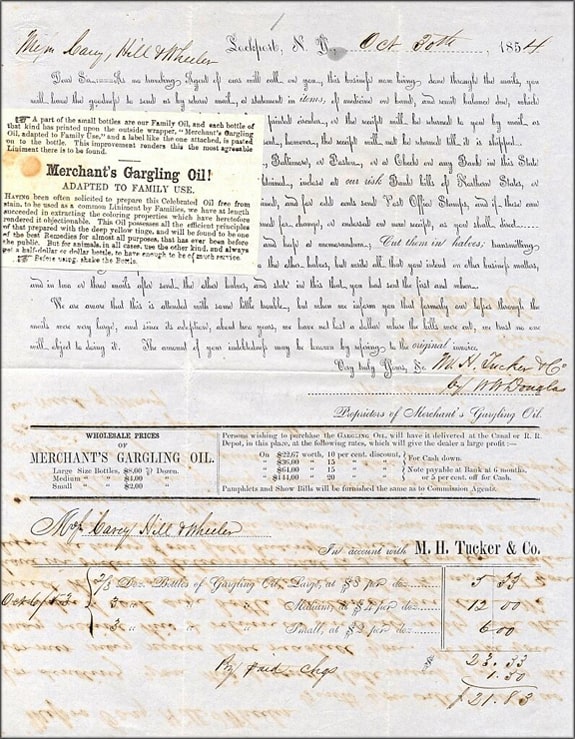
As a teenager, John Hodge joined the company and was elected Secretary when M. H. Tucker & Company was incorporated in 1858. Dr. Merchant’s Gargling Oil thrived under the marketing expertise of Tucker. He seemed to be far ahead of his time in terms of promotion and marketing. One scheme involved sending a dozen bottles of Dr. Merchant’s Gargling Oil in a satin-lined oak box to the Sultan of Turkey. The Sultan never acknowledged the gift, but American newspapers picked up on it, and sales of gargling oil shot up. Tucker also developed the marketing slogan “Good for Man and Beast!”

Over time, different specialized products were developed for animals and humans. The product for beasts was packaged in a yellow wrapper, and the human variety used white packaging. In recognition of the special status of the Sultan of Turkey, the gargling oil for animals had a drawing of an Arabian Stallion having his legs massaged by a turbaned groomsman. The oil for human application had a picture of a man and wife and a table with liniment bottles upon it.
John Hodge advanced to company president in 1886, taking over the reins from Tucker. He also had the good sense to marry Tucker’s daughter. Hodge, too, was a promotional wizard. He had a keen insight into the world of advertising. He began a program of painting billboards on anything stationary along the route of the Erie Canal. Barns served as his favorite canvas. He even convinced the owners of the youthful Maid of the Mist company to allow a gargling oil advertisement on the side of their boat. His grand achievement has to be a reported advertisement painted on the Rock of Gibraltar.
By the time of Hodge’s death in 1895, Dr. Merchant’s Gargling Oil was sold worldwide and was one of Lockport’s principal industries. The product lasted almost 100 years, going out of business in 1928 when the factory burned down.

The American glass industry expanded in the colonies after the American Revolution, and by the 1800s, considerable glass was made in New York State. Two prominent glasshouses were established in Western New York during the nineteenth century. One began in 1840 in Lockport in Niagara County, about twenty miles northeast of Buffalo; the other started in 1849 in Lancaster in Erie County, south of Lockport and about ten miles east of Buffalo. Both glass factories operated until shortly after 1900.
Both Lockport and Lancaster produced a specific blue glass familiar to collectors. It was a clear, light, delicate blue, with the Lancaster color tending to be a bit lighter than the Lockport blue. Both Lockport and Lancaster made other blues, rich deep greens, yellow-greens, olive-greens, blue-greens, and ambers or browns, which sometimes appeared black.
See the museum examples of GXIV-6 “Traveler’s Companion” and Stylized Duck – “Lockport Glass Works” and Star historical flasks in yellow-green and medium blue-green.
The first glass factory, known as the Lockport Glass Works, operated out of a rented building at Gooding and Grand Streets in Lockport, New York. It was opened in the spring of 1840 by Twogood and Company of Mt. Morris, New York. After about a year, the firm failed because of insufficient capital and was taken over by Parson and Moss, who controlled it for a year before giving it up to Silas H. Marks. Marks entered a partnership with William Keep, A. J. Webber and G. W. Hildredth, and the plant operated under the name of Hildredth and Company beginning in 1845. Hildredth and Company employed 50 to 55 men, of whom about 18 were blowers. The average wage was $2 a day, a good salary. In the spring of 1846, the firm built a modern plant at Green and Transit Streets.
In 1850, Webber died, and his heirs sold his interest to Francis Hitchins, who bought out the firm in 1853 and managed it until 1866, when it became known as the Lockport Glass Manufacturing Company. Five trustees managed it: James Maroney, Patrick Glynn, Edward Batten, Joseph Batten, and Andrew Garfield. In 1869, S. B. Rowley purchased the plant and made the “Gem Butter jar,” “The Hero jar,” and “All Right” fruit jars. Joseph Batten held a controlling interest.
In 1872, the business was sold to Alonzo J. Mansfield, who enlarged the factory, which burned in 1878 but was rebuilt. The company was reorganized in 1904 with Alonzo J. Mansfield, president, S. J. Clark, vice-president, and George E. Emerson, secretary-treasurer. In 1908, the company went out of business.
In 1900 another glass factory was established on Michigan Street and called the Lockport Glass Company, so from 1900 to 1908, Lockport had two glass factories. Officers of the new company were W. W. Storrs, president; C. G. Sutliff, vice-president; and J. Milton Woodward, secretary-treasurer. They made fruit jars, pickle bottles, and other small containers. In 1919, the Thatcher Manufacturing Company, which owned plants in Elmira, Olean, Long Island City, New York, and Streeter, Illinois, bought the plant and concentrated on milk bottles. The introduction of paper milk containers forced them to switch to jelly, pickle, and coffee jars, and they closed the factory in 1942.
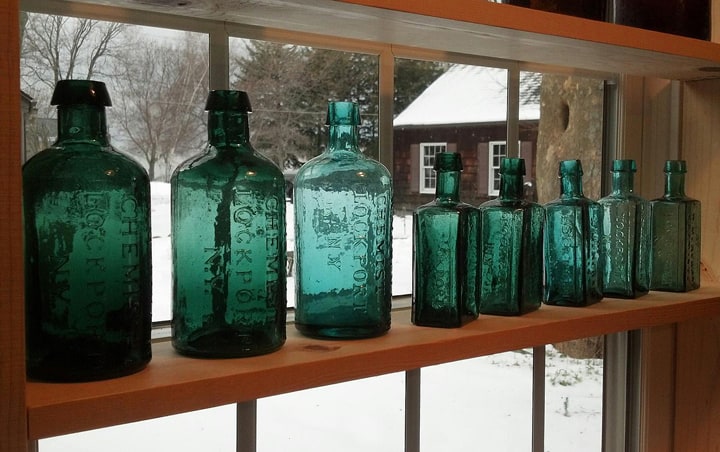
Primary Image: G. W. Merchant Chemist Lockport N.Y. bottle imaged on location by Alan DeMaison, FOHBC Virtual Museum Midwest Studio
Support Image: “G.W. MERCHANT / CHEMIST / LOCKPORT / N.Y.”, probably Lockport Glass Works, Lockport, NY, 1850 – 1860. Beautiful, deep cornflower blue, cylindrical, applied sloping collar – iron pontil, ht. 7”, very near mint; (just a trace of light wear and a touch of very light residue, or milkiness, in the shoulder, barely noticeable). A very rare and beautiful color for a ‘cylinder Merchant’ (or any Merchant bottle). One of just a small handful known in this cornflower blue coloration. Provenance: Fred Swiechowicz collection. One of only a half dozen, or less, known in this cornflower blue coloration. – John Pastor, American Glass Gallery, Auction #34
Support Image: Auction Lot 183: Two “G. W. Merchant / Lockport / N.Y.” Medicine Bottles, Lockport Glass Works, Lockport, New York, 1843-1860. Rectangular with beveled corners, aquamarine and rich blue green, applied sloping collared mouths – pontil scars, ht. 4 7/8 inches and 5 inches. AAM pg. 350 The blue green example has a small “+” embossed on the reverse. Both are in fine condition. Timothy and Christine Hill collection. – Norman Heckler Jr. & Sr., Norman C. Heckler & Company, Auction #151
Support Image: Auction Lot 12: Two “G. W. Merchant / Lockport. N.Y.” Medicine Bottles, Lockport Glass Works, Lockport, New York, 1860-1870. Rectangular with beveled corners, medium yellow green and medium blue green, applied sloping collared mouths – smooth bases, ht. 4 7/8 inches and 5 1/8 inches. AAM pg. 350 The blue green example is lacking a period after the “Y”. Beautiful colors. Fine condition. Timothy and Christine Hill collection. – Norman Heckler Jr. & Sr., Norman C. Heckler & Company, Auction #151
Support Image: Auction Lot 26: “G.W. Merchant / Chemists / Lockport / N.Y.” Medicine Bottle, probably Lockport Glass Works, Lockport, New York, 1845-1860. Cylindrical, brilliant medium blue green, applied sloping collared mouth – large iron pontil mark, ht. 6 3/4 inches. Great condition, beautiful color, an exceptional Merchant bottle. – Norman Heckler Jr. & Sr., Norman C. Heckler & Company, Auction #98
Support Image: Auction Lot 192: “Gargling Oil / Lockport. N.Y” Medicine Bottle, probably Lockport Glass Works, Lockport, New York, 1860-1880. Rectangular with rounded corners, medium yellowish green, applied sloping collared mouth – smooth base, ht. 7 1/8 inches. AAM pg. 351 A most appealing example with a crude “orange peel” exterior surface and a beautiful and unusual color. Fine condition. – Norman Heckler Jr. & Sr., Norman C. Heckler & Company, Auction #185
Support Image: Grouping of G.W. Merchant bottles showing a nice range of blu/green colors in the Lockport Glass. – Mike Stephano
Support Image: Grouping of G.W. Merchant bottles in a window. – Dave Kam
Support: Reference to Lockport Glass Works by Bill Lockhart, Beau Schriever, Bill Lindsey, and Carol Serr
Support: Reference to Merchant’s Gargling Oil – “Good for Man and Beast” Peachridgeglass.com, August 2012
Support: Reference to Looking at a Collection of Merchant’s Gargling Oils Peachridge Glass, November 2013
Join the FOHBC: The Virtual Museum is a project of the Federation of Historical Bottle Collectors (FOHBC). To become a member.

